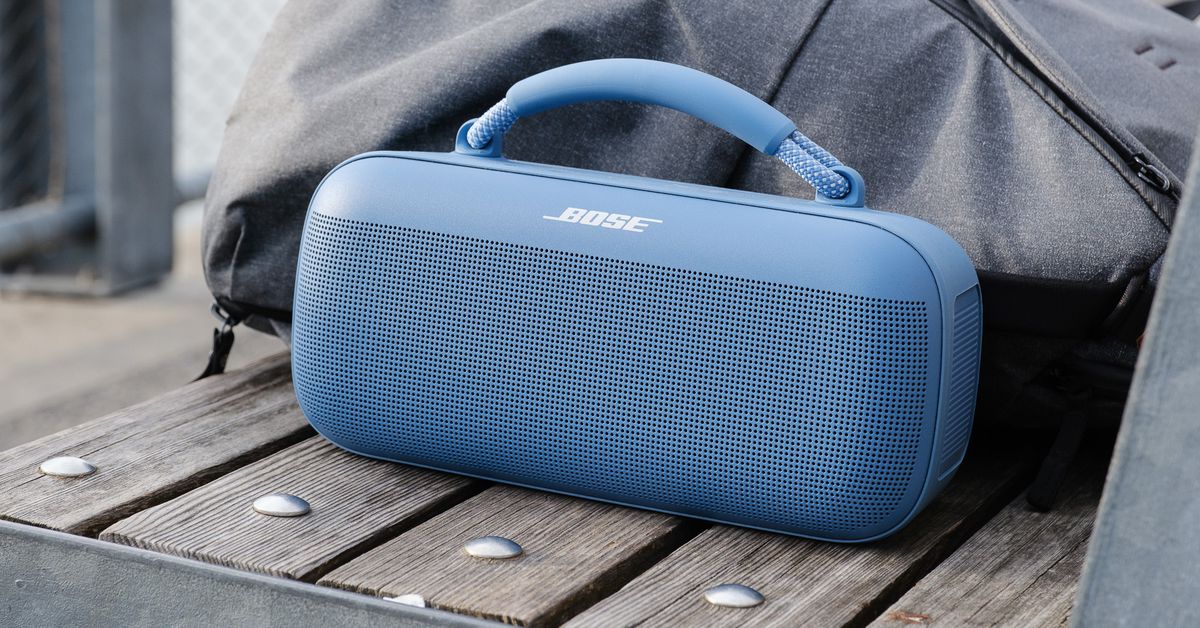Bose is undoubtedly best known for its noise canceling headphones. But you know what else the company has always been damn good at? Portable speakers. I still remember being blown away by the original SoundLink Mini (and later its successor). Something about the magic of Bose audio processing can make these relatively small speakers sound much bigger and wider than they really are, and that remains true with the newer SoundLink Flex — which remains one of our favorite picks.
Now Bose has introduced a larger speaker, the new SoundLink Max, which follows the styling of the Flex while adding key improvements. It provides a much richer sound that is now in true stereo. (The Flex, like other miniature speakers in its class, uses a mono driver.) But here you get dual tweeters along with passive radiators on either side for a much fuller listening experience.
Size-wise, especially with the handle, it feels like a lunch box: a very thick 4.9-pound lunch box of sound encased in silicone with a metal faceplate. Look, all I’m saying is, this thing can be a weapon if you ever need it. You can get real swinging power with the removable handle, which can be swapped out for other colors or a longer strap.
At 4.73 inches tall, 10.42 inches wide, and 4.13 inches deep, the Max’s body is noticeably bigger and sturdier than the Flex’s, but it’s far from over-sized. Once I started playing music, I was quickly blown away by the remarkably wide soundstage it could produce. This is one of those speakers where, if you close your eyes, your brain will be convinced that the sounds are coming from far beyond the device’s physical footprint. And the bass packs a lot of punch. Some people may find the default EQ a little bright, but you get full control over that balance in the Bose mobile app.
The Max does best indoors, where the Bose processing can rely on walls and bouncing sound waves. Out in the open, in wide open spaces, this audio performance feels less ‘maxed out’, but it’s still above average for its size – especially if you hit the bass EQ. In addition to the usual AAC and SBC Bluetooth codecs, the Max also supports AptX Adaptive for higher bitrate audio from Android devices. Bose claims up to 20 hours of battery life, which I find to be accurate based on my listening at moderate volumes so far.
The speaker has an IP67 rating for dust and water resistance. It will even float if you accidentally drop it in a pool. However, its rear ports are left uncovered and exposed to the elements, so you’ll want to dry off the Max and let it sit for a while before plugging it in. The silicone that wraps around the sides and back is stretchy, but the tradeoff is that it’s a magnet for dust and lint. (At least you can clean it easily.)
The Max’s metal front grille can accommodate scratches more easily than I’d like. My camera lens bumped into it and just like that the powder coating left a small permanent mark. That blue looks pretty nice, but I wish Bose would offer an unpainted silver edition that would cover up such blemishes in the long run – especially for a speaker that’s otherwise pretty solid.
Then there’s the $399 price tag. SoundLink Max finds itself in no man’s land. It is more expensive than competitors from JBL, Anker / Soundcore and others – and no a lot cheaper than many “smarter” options like the Sonos Move 2. The Bose speaker has no Wi-Fi connectivity to speak of, so you’re at risk of notification sounds (or calls) interrupting your music. It also doesn’t have a speakerphone feature, which is the Flex does include. Go up a bit in price and you’ve entered much larger speaker territory with popular choices like JBL’s Boombox 3 and Sony’s new Ult Field 7 that can hold their own better outdoors. Even Bose’s premium processing can’t match these larger drivers and their more impactful sound once you really turn up the volume.
Bose throws in a few bonus features to justify the premium price. The Max supports multipoint Bluetooth, so two devices can pair to it at the same time. There is a 3.5mm aux input for external audio sources, and the USB-C port, which is used to power the speaker, can also provide power to mobile devices. Now we’re at the point where I wish the USB-C port could double as an audio input. As it is, I had to grab a headphone jack adapter from my bag when plugging in my phone for lossless playback. I’m just happy to have any kind of line. Later this year, you’ll be able to stereo pair the Max with another device or group it with other Bose speakers.
At the end of the day, the SoundLink Max will attract the same people who have always bought Bose speakers. If you want to splurge on a very simple, elegant, great-sounding speaker, this is it. But the Bose tax and that $399 price tag will inevitably make others think twice – understandably so. I already plan to wear this thing a lot in the coming months, but this is a luxury purchase through and through.
Photography by Chris Welch/The Verge



